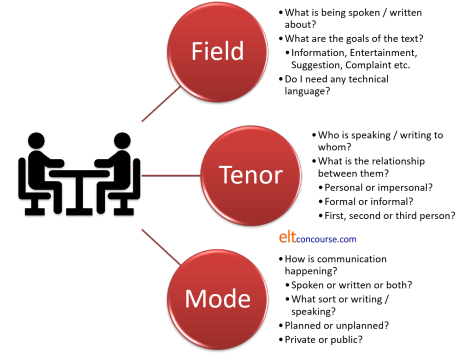Delta: teaching a skills-focused lesson
 |
This short guide is intended to be read in conjunction with (or
after) the ones which focus on meeting the teaching criteria.
It will, insofar as this is possible, avoid repeating anything
contained in those guides which apply to meeting the teaching
criteria on Delta in general.
If you have not yet looked at the guides to meeting the teaching
criteria,
click here for the index.
Those guides are supplemented by a guide to the things you need to
avoid doing when teaching on a Delta course, in particular.
Click here to go to that
guide.
There are a number of links in this guide to other sections of the
guides to Delta Module Two which you may like to follow as you go
along. They will open in a new tab so you can simply
shut the page to come back here.
Here, we are concerned with planning and teaching skill-focused
lessons on Delta.
For elusive reasons the Delta syllabus (and others constructed in
Cambridge) is wedded to the idea that you should demonstrate the
ability to teach skills not once but twice. So be it.
The issue, of course, is that unless you are teaching young children
or on an adult literacy course, most of your learners already know
how to read, write, listen and speak. What they need now is to
learn how to do those things in English.
It follows, therefore, that an important thing to keep in mind is
that by the end of your lesson the learners will have learnt
something, not just practised it.
If you are tempted, therefore, to practise scanning and skimming
above A1 level, or gist listening skills, think again. Your
learners have almost certainly been there and done that.
 |
Planning |
All plans should, of course be unique and focus on the lesson you are going to deliver. On any delta course, you will be criticised for any hint of a one-size-fits-all section of a plan.
There is a separate guide to planning for a Delta lesson which considers all the assessment criteria for a plan and how to make sure you meet them. Here, we will focus on avoiding the pitfalls of planning to teach skills-focused lessons.
- The class profile

In addition to
a brief general overview of the group of learners and the course,
this part of the plan requires you to provide
information about individual learners relevant to the lesson
and it is the last four words which are important.
Your overview (usually set out as a grid) will mention things like motivation, preferred learning activities, interests, special needs, classroom behaviours and so on which will, of course, be relevant to the lesson and its topic. You should also have a column headed something like For this lesson in which you comment (briefly) on the individual learners' abilities in the skill you are targeting. Do not be vague here and make sweeping generalisations along the lines of
Has difficulty reading
Is reluctant to speak
Finds listening to natural speech challenging
Writes slowly and carefully but is still having trouble with the script
etc.
These are valid statements to make but you need to address the specific subskills that your lesson targets. Here are some examples of better expressed profile sections:
has expressed an interest in reading academic texts so this lesson on unpacking complex nominalisations should help him do so.
finds responding in real time to conversational initiations very challenging because she over monitors herself. She should find today's focus on prefabricated language chunks particularly appealing and helpful.
is concerned to make sure she understands everything she hears and is easily blocked by any unknown or unrecognised lexis. She needs to focus on monitoring what she hears for relevance and having the confidence to ignore what she doesn't understand.
intends to start an undergraduate course in the USA next September and will need to write reports in English. He is confident in using specialised engineering lexis but will benefit from this lesson which focuses on the information staging and main discourse features of Report genre.
Assessor complaints to avoid:
The profiles of learners are helpful in a general way but provide only patchy data concerning the skill in general with nothing specific to the focus on reading for gist.
The individual profiles refer only to general language ability, not to the learners' speaking skills.
and so on. - Aims and objectives

This part specifically requires you to have
clear and appropriate overall aims and learning outcomes for the lesson in relation to language systems and/or language skills and learner needs
The critical part here is and/or. Clearly for a skills-focused lesson, you will need an explicit and clear statement of what subskills the learners will be able to use or use better by the end of the lesson. However, no lesson is likely to be language free or free of some language which is new or needs recycling so you should not lose sight of the need to have a subsidiary aim which focuses on language systems.
Here are two examples of how to meet this criterion for a reading skills or speaking skills lesson:
By the end of this lesson, the learners will be better able to access authentic report texts to extract the key data by using knowledge of the conventional information staging and structure of such texts.
Subsidiary objective: the learners will have been alerted to and be able to use the terms to define various stages of a report text, in particular abstract, supporting data, research data, exemplification, conclusion, literature survey ... and be aware of where they conventionally appear.
By the end of the lesson, learners will be able to recognise linguistic and paralinguistic signals which are invitations to take a turn in informal conversations.
By the end of the lesson, learners will be able to use a limited range of linguistic and paralinguistic signals to signal an invitation to take a turn in informal conversations.
Subsidiary objective: the learners will be able to recognise and use prefabricated chunks of language which indicate an invitation to take a turn. In particular, question tags and their intonation patterns, falling-tone questions including, Don't you agree?, Isn't that the right?, What do you day? Or am I wrong?
Subsidiary objective: the learners will be able to use paralinguistic features with these language chunks including making eye contact, voice tone lowering and glancing downwards.
Assessor complaints to avoid:
The aims set out what is to be achieved but not how in terms of the subskills which are the targets.
The candidate has not set out in adequate detail which subskills of ... she is targeting.
The candidate has failed to include the extensive amount of lexical work which was involved in the lesson.
and so on. - Analysis

You are required to analyse your target skill(s) in terms of linguistic, discoursal and communicative features.
You will find a fuller guide to analysing skills for a Background Essay in this section of the site. From that analysis, you need to extract only what is relevant to this lesson. Do not be tempted to cut and paste because that betrays an inability to select what is relevant.
Your analysis should be only of the (sub)skills which form the targets of your lesson and should be exemplified through the materials you intend to use. This is not the place to make general comments about macro-skills.
There are three elements:
linguistic: what are the language features of the skill(s) which form the targets of your lesson?
This might include co-text, word class, phonological features, conjuncts, deixis and a host of other factors.
discoursal: what are the elements here?
This part might include theme-rheme connections, IRF sequences, shared knowledge between speakers and listeners, turn-taking signals, clarification strategies and a whole lot more.
communicative: what functions and notions are involved in the skill(s) you intend to teach?
This might include adjacency pairs, notions of distancing and politeness, genre-specific information staging, communicative purposes, setting-specific skills use and much more.
Assessor complaints to avoid:
There is no analysis of the subskills which form the target of the lesson.
The analysis lacks detail concerning how this subskill is employed.
The candidate has failed to analyse the communicative effect of the competent use of the subskills involved in the lesson.
and so on. - Timetable fit

Focus on the skills development programme for the group, not on everything they have done / will do next.
This means setting out quite clearly what allied skills work they have done and what is planned. For example, if your lesson targets a specific speaking subskill, you need to say what other speaking skills lessons they have done and how that links with what you are doing and say how you intend to go on helping the learners to develop their speaking skills.
Most skills lessons also have a systems input of some sort (see under aims and objectives). Do not forget to include these in the timetable fit in terms of what language they have already encountered and what they will meet next.
Assessor complaints to avoid:
The candidate has outlined in general terms what the skills syllabus for this class is but has not made specific reference to the skills involved in this lesson.
The candidate has failed to explain how this subskill will be consolidated in future.
There is no mention of any previous work which has been done concerning this skill.
and so on. - Assumptions, anticipated problems and solutions

You are obliged here to identify what assumptions you are making:
relevant to the aims and learning outcomes of the lesson
so make sure that you are focused on the deployment of the (sub)skill(s) you are targeting.
What level of mastery of the skill are you anticipating that the learners already have, if any?
What skills, if any, that the learners already have can be transferred to your lesson targets?
Are you assuming that the learners will be able to handle the linguistic content of the lesson as well as the skills objectives?
You are also asked to
anticipate and explain potential problems
and
suggest appropriate solutions to the problems outlined
The problems and solutions you focus on here should primarily not focus on the lesson aims (obviously) but should refer to the skills requirements and any difficulties you perceive concerning the language and the tasks (as well as the general issues outlined in the overall guide to planning at Delta level).
Assessor complaints to avoid:
The candidate has not addressed the issue of how well the learners can already deploy allied subskills.
The candidate has failed to explain how he will address the issue of potential lexical overload in the text.
There is no mention of a viable solution to the learners' tendency to avoid applying this subskill.
and so on. - Procedures and materials

The first issue is to make sure that you plan in a section of the lesson in which the skill can be explicitly described and understood by the learners. You are not smuggling in work on subskills. You need at some point in the lesson to have a phase in which the learners are seen to be aware of what skills they are applying, how and why.
Secondly, a serious problem with all skills lessons is ensuring that the skill can actually be deployed in the time available for the lesson (40-60 minutes only). There is, therefore, a pressing need to limit skills objectives so that the learners can demonstrate to their and your satisfaction that they are better able to do something in the language that they could not do at the outset.
Avoid, therefore, lessons whose entire content concerns preparation to apply a (sub)skill. If, once you have done the majority of the planning, it looks as if you will have less than, say, 20% of the time available for the application of the skill(s), you need to rethink your aims and be less ambitious.
Assessor complaints to avoid:
There is no stage of the procedure in which the focus on the subskill, its usefulness and appropriacy to the text type is made clear to the learners.
The candidate planned the lesson so that there was insufficient time at the end for the target subskills to be applied so achievement cannot be demonstrated.
The materials were not suited to the application of the relevant subskills in the time available.
and so on. - The commentary

Here you need to focus on the (sub)skill(s) you are targeting, obviously, and you need to make it clear how your planned lesson will allow for the perceived development of the skills.
Assessor complaint to avoid:
The commentary makes clear why this lesson structure has been chosen and why the topic should appeal to the learners but the candidate makes no mention of the usefulness of this subskill for the learners.
To avoid that issue, it is helpful to set out here what it is about the context of the situation that you are going to focus on in the lesson. The diagram, taken from the essential guide to teaching language skills looks like this:

When planning the lesson and writing the commentary, you are advised to bear all that in mind so that it is clear that you are concerned to show that your learners will know which skills they are using, how they are using them, why they are using them and with whom they are using them.
The guide from which that is taken, has some suggestions for ways to alert your learners to the information they need. It is linked here and opens in a new tab.
 |
Teaching |
Most of the assessment criteria for teaching are generalisable to
any lesson (they have to be) so for detailed advice concerning how
to meet them, you should refer to
the
guides to meeting the teaching criteria. In that you will
also find examples of the criticisms from assessors that you should
try to avoid being levelled at you.
Here we will look at meeting the criteria in a skills lesson, in
particular, and that mostly concerns certain criteria only.
We'll take each category in turn:
- Category 6 of the criteria: relationships with the
learners

There is some advice concerning how to meet the four assessment criteria in the section in the guides linked above.
All that needs to be added here is that for a skills lesson, you need to be alert to whether you are making sure that everyone has an equal opportunity to engage with the materials and apply the skills.
For example:- If you are teaching a reading lesson, have you allowed for the extra time that people with other scripts may need to process the written word?
- If you are teaching speaking, have you made sure that any role play you set up allows both (or all) parties to an exchange to practise the skills which form the lesson's targets?
- If you are teaching listening, have you ensured that the material is equally accessible everywhere and for everybody. If it is recorded, for example, is it equally clear everywhere in the room?
- If you are teaching writing and want to take a cooperative approach, will all the members of a pair / group be required to practise the skills or can some sit back and let others get on with it?
- Category 7: language models and information

This includes how well you exploit and build on what the learners supply.
In a skills lesson, in particular, you need to focus on criterion 7d: giving accurate and appropriate information. You will not meet this criterion if you do not consistently alert the learners to what skills they should be applying, how and why. It is not enough that your materials and procedures automatically make people apply particular skills and subskills; you have to make sure that the learners notice the skills they are applying and know why they help. - Category 8: procedures and monitoring

With a skills lesson, you need to be very alert when you plan and when you teach. Monitoring is the key criterion here (8d). With much skills work it is not immediately obvious whether learners are applying the skills and subskills you want them to apply so you need to be active, alert and aware of what the learners are really doing. Try to keep your focus and do not slip into correcting peripheral language when it is the skill that is the focus.
When you monitor, there are two purposes:- check monitoring involves making sure quickly that
everyone in the room is on-track and doing what you asked
them to do. For example:
- If you are keen to promote skim reading for gist, make sure you get around the class and can satisfy yourself that nobody is reading word by word and trying to understand everything
- If you want people to make brief notes for speaking or writing exercise to follow, make sure that nobody is laboriously writing complete sentences
- If you want people to monitor a listening text for relevance, make sure they know what they are listening out for and that they are not simply trying to understand everything they hear
- support monitoring involves making sure that you are on
hand when needed to help and support the learners.
Many skills are unfamiliar to your learners so they may need
considerable help to apply them to the task you set.
For example:- If you are keen to promote skim reading for gist, you may need to nudge the learners into reading the opening and closing paragraphs only or to find the topic sentences of each paragraph to get the main message
- If you want people to prepare an oral presentation, they may need help in selecting the ordering of what they want to say and that may require you to suggest what are the most important points and nudge the learners into seeing connections rather than random thoughts
- If you want people to work together on a written text, satisfy yourself that not only one learner is doing all the work and that everyone is practising the (sub)skill which is the target of this phase
- check monitoring involves making sure quickly that
everyone in the room is on-track and doing what you asked
them to do. For example:
- Category 9: management

Two critical criteria here for a skills lesson concern adapting the plan to emerging needs and ensuring learners remain focused.- With skills lessons, it is often hard to judge in advance how well the learners will grasp the subskills you are trying to get them to use. Never be afraid to stop, rewind part of the lesson and get people back on track and using the skills. Do not be tempted to carry on even though you know that some of the learners are not using the skills which form the targets of your teaching.
- Equally, it is easy for learners to wander off track
when asked to apply new skills so you need to be alert to
keeping them focused. This usually means asking
instruction-checking questions frequently to help them stay
on course. You may want to ask, for example:
- Are you going to read all the text?
What are you looking for in the text?
Where will you expect the topic sentence to be? - Tell me the two things you need to understand from what
you will hear.
Will you be able to understand every word you hear?
Are you focused on the time or the place? - Are you going to write full sentences?
Will you be working alone or with two partners?
When you have written 5 points, what do you do next? - In this exercise are both people equal or does one have
more authority? Which one?
Do you need to be polite?
Who speaks first?
- Are you going to read all the text?
If you would like to go through some of the guides to meeting Delta criteria now, use this menu.
The teaching criteria sections and preparing to teach:
| Planning for Delta | Section 6 | Section 7 | Section 8 | Section 9 | Preparing to teach | Teaching systems |
| The criteria one by one | relationships | language | procedures | management | visualising the lesson | a parallel guide |
